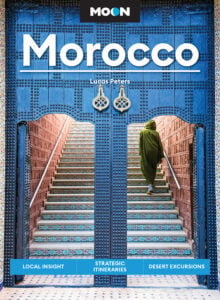
The long dusty road leading to Tamegroute takes me back in time. The family-run pottery workshops in the oasis, not far from the Sahara desert, are among the oldest in the country. Dating back to the mid-1600s, they remain virtually unchanged. Artisans still work with manual pottery wheels in a building made from the same clay used to make pots and tiles. Finished pieces are fired in multi-chambered wood stoves.
These pottery workshops aren’t just old, they’re also home to one the greatest secrets of Morocco. There is a particular shade of green traditionally used in the pottery of this region. It’s a green you won’t be able to find anywhere else.
Said Dani sits at the door of his family’s shop creating intricate designs on a plate with paint and a syringe. His family immigrated from Mali five generations ago, bringing their craft with them.
“They made bowls from wood but when they got to Morocco they thought of making them from pottery instead,” he says.
His family, along with others that settled Tamegroute, decided to develop a green glaze since it’s the color of Islam. Today, besides the traditional green pottery, Dani also creates pieces of pottery with multi-colored patterns. He uses the same needle technique that local women use to draw henna tattoos.
“I noticed that visitors to the shop have different color preferences,” he says. “Green isn’t to everyone’s taste.”
The Secret of Tamegroute’s Green Pottery
The artisans source all their raw materials from nature. Clay is collected from nearby palm groves by digging deep holes in the ground up to ten meters deep. It’s a dangerous practice and has claimed the lives of a few workers over the years. (Fortunately, there has only been one accident recently and it was relatively minor). Palm tree branches are mostly used as fuel for the stove, although tamarisk and eucalyptus chips left over from local carpenters are sometimes added.

The signature green glaze contains a high proportion of manganese, silica, cobalt, a hint of copper, barley flour, and a particular type of rock found in local mines a few hundred kilometers away. The concoction is mixed with water in a huge basin and left to thicken for about a week. But it’s the firing process that is thought to be key to the multi-shade green color that has yet to be replicated elsewhere.
“The color never fades,” says Dani. “Even when exposed to heat or humidity it doesn’t change.”
Apart from pottery, the artisans also make tiles which are in high demand. From houses to mosques, The tiles are a common sight in many buildings in the region. I’ve spent a few afternoons helping the workers make them. Slabs of clay are dusted with sand before they are flattened in a mould using a precise technique that I gradually begin to master. The process is almost meditative. We often spend hours churning out rectangles of clay while the rhythm of Arabic pop music sets the pace.
Today’s Green Pottery Artisans
Their age-old ways are about to change, though. Dani tells me that after a visit from the king about five years ago, the government decided to build a modern workspace for them down the road. The spacious quarters, which have now been completed, are equipped with electric pottery wheels as well as solar and gas-powered kilns, which will do away with the billowing smoke that their current stoves produce.

Many of the artisans are looking forward to having more space to work. The families have grown and they are often cramped. But for Dani, the biggest concern is whether the modern stoves will be able to replicate the same irregular green color they are famous for. Several years ago they were given a gas stove but they found that the glaze became a uniform green color. Thus, they continued firing their pieces the traditional way.
Dani is willing to give the new space a chance. However, he won’t let anyone touch the historic workspace. Nestled within the surrounding kasbahs, there are plans to restore it so that visitors can still visit the pottery’s birthplace.
“It’s our treasure,” he says. “One day the original green pottery will be worth a fortune.”
About the Author
 Sandrine Ceurstemont is a freelance science writer currently based in Morocco. Her interests range from bizarre animal behaviour to the unknowns of the vast world underwater to new robots. Since living in Morocco, she has become interested in local innovations and has written about one of the world’s largest solar power plants in Ouarzazate. She frequently writes for New Scientist and the BBC.
Sandrine Ceurstemont is a freelance science writer currently based in Morocco. Her interests range from bizarre animal behaviour to the unknowns of the vast world underwater to new robots. Since living in Morocco, she has become interested in local innovations and has written about one of the world’s largest solar power plants in Ouarzazate. She frequently writes for New Scientist and the BBC.
[wpdreams_rpp id=0]








